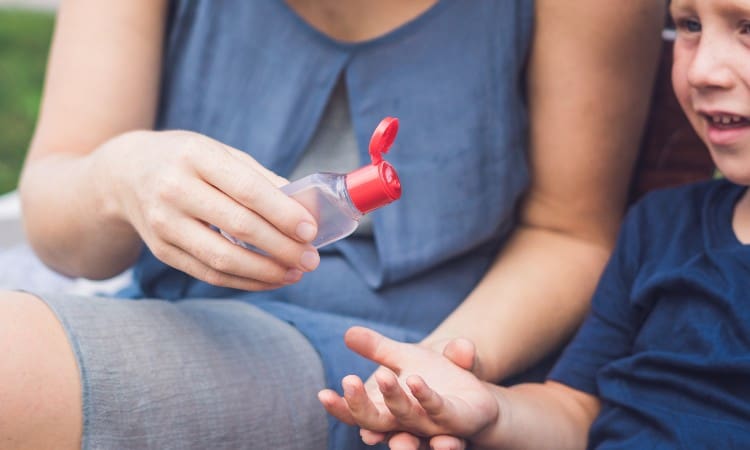The use of hand sanitizer has become part of the daily hygiene routine for many of us. Finding strange little stains on our clothes has also become more frequent. Are the two related in some way? Does hand sanitizer stain clothes?
Hand sanitizers can cause stain like marks on clothing. Some contain alcohol, a known stain remover, others benzalkonium chloride which is a bleaching agent. When the sanitizer comes into contact with clothing, it can remove the color from the fabric. The marks are known as bleaching spots.
We know that hand sanitizers can keep us protected from germs and illness. But can we safeguard our clothing against the bleaching properties of sanitizers?

Does Hand Sanitizer Stain Clothes?
Although hand sanitizers don’t ‘stain’ clothes, some fabrics can be damaged by the ingredients found in many brands. As we apply the sanitizer, it can spill or splatter onto clothing and other surfaces. When the liquid lands on fabric, it forms little discolored spots that can look like stains. The marks are in fact where the fabric has been bleached.
Alcohol is one of the main ingredients in sanitizers due to its antibacterial qualities. It’s also a known stain remover. This can be a bit of a problem when it comes to our clothing. As far as alcohol is concerned, there is no difference between stains and colors.
The stain removing properties of alcohol relies on its ability to act as a bleaching agent. In other words, it alters the look of an item by removing its color. Unfortunately, because the alcohol is dropped in random places and tiny amounts, the bleaching process only works in affected areas. Leaving a spotted effect on the fabrics.
What is Hand Sanitizer Made From?
There are two types of hand sanitizer. The first is alcohol-based. This one is the most popular as it is easier to use. To be effective against germs, it needs to contain at least 60% alcohol. Not the type you can drink, though. The alcohol in hand sanitizer is normally ethanol or rubbing alcohol, also known as Isopropyl alcohol.
Non-alcohol based sanitizers are the second type. As the name suggests, it’s alcohol-free. One of the ingredients is benzalkonium chloride, a germ-killer. Whereas alcohol sanitizers are smooth, runny, and dry on your hands, non-alcohol ones foam up like soap. They are more liquid than gel and tend to be less convenient to use, so aren’t as popular.
Although they contain slightly different things, both alcohol and non-alcohol hand sanitizers can cause stain-like bleaching damage.
What Fabrics Can Be Damaged by Hand Sanitizer?
Most fabrics can be affected by the bleaching properties contained within hand sanitizer. Depending on the color and type of fabric, the damage may be easier to hide. Light-colored material for instance is better at concealing the paleness of the bleached spots.
Dark clothing and fabrics with a special finish are another matter. Any kind of staining on a plain dark material tends to stick out like a sore thumb. The bleaching process causes colors to be lightened, making damage to darker clothing more noticeable. It’s not just dark colors, though. Some materials like leather and suede are susceptible to sanitizer damage too.
Leather is available in a range of dyed colors. When a bleaching agent comes into contact with the dye on the leather, it removes the dye, taking the leather back to its original color. Usually, tan or a very light brown. Clothing, shoes, purses, and upholstery (automobile seats too) are at risk of sanitizer bleaching.
Suede is particularly susceptible to liquid damage. Rainwater and a pair of suede boots is a recipe for disaster since suede isn’t naturally waterproof. Nor is it water-resistant. In fact, it is extremely porous and will suck up any liquid around it. As hand sanitizers are liquids and gels, suede faces the double whammy of liquid damage and bleaching.
Some clothing fabrics are designed to be luxurious. Silks and chiffons are known for their delicate properties. Alcohol can strip the color out of these fragile materials in the same way it does for harder wearing fabrics. The natural instinct to rub stains to remove them can be the undoing for many a silk tie or blouse.
How to Get Hand Sanitizer Out of Clothes?

There is no easy way to get hand sanitizer out of clothes. You can try to reduce the size of the damage or hide it in some way. The longer hand sanitizer is left on clothing, the more damage it can do.
Try to gently scrape off as much of the sanitizer as you can, without rubbing too hard. Then wash the garment as soon as possible. There are no guarantees this will work, but it’s worth a try.
Since the sanitizer bleaches fabric, repairing the garment can be tricky. If it’s a dark-colored item, you may find a closely matched fabric marker pen will help to camouflage the damaged areas.
Alternatively, depending on the location of the damage, you could hide it with embellishments such as buttons or patches. If the article of clothing has a special finish or is leather or suede, take it to a professional cleaner. Attempting to clean it yourself could cause more damage, even rips or holes.
The easiest way to get hand sanitizer out of clothing is to make sure it doesn’t touch them in the first place. Always make sure you keep your hands away from your clothes until the sanitizer is dry. Remember not to splash the liquid or gel as you pour or squeeze it onto your hands. Keeping a firm control over the flow of the sanitizer will reduce the likelihood of clothing damage.
Other Liquids That Stain Clothes
So far we’ve looked at stains caused by hand sanitizers containing Isopropyl alcohol, also known as rubbing alcohol. Other liquids can cause marks on clothes. The first on the list is one we all use.
Water
From rainwater to accidental splashes from drinks or washing, water can be devastating to certain fabrics. Suede in particular can be ruined beyond repair by even the lightest of summer rain showers. Leaving white watermarks on non-waterproof surfaces, water damage is hard to fix on items not designed to get wet. The best solution is to ensure you treat your garments with water protective products before taking a stroll in the rain.
Liquor
Liquor includes vodka, whiskey, gin, tequila, and other alcoholic drinks collectively known as spirits. These drinks will have the same effect on your clothing as the alcohol found in hand sanitizers.
Red Wine
Another form of alcohol and just as likely to damage your clothes. Notoriously difficult to clean, this drink will leave an angry red blotch on carpets or clothing. There are two ways to deal with a red wine stain.
For clothes, pull the affected area across a bowl until it’s as tight as a drum. Cover the stain in salt and pour boiling water over it. Make sure to wash it in a hot setting as soon as you can.
The second method, use vinegar to soak the stain, and then rinse and allow to dry. If your garment is not washable or has a special finish, take it to a professional cleaner.
Beer
As beer is water-based, getting rid of stains from most items is straightforward. Get a wet cloth and gently dab at the stain and then wash as soon as possible. You can even use a laundry stain remover. If your garment is not waterproof or not designed to be washed, seek professional cleaning advice.
Coffee
Another everyday favorite and a frequent offender, when it comes to stains, is coffee. Use baking soda and water to soak the stain and then wash as normal. Although they look bad, coffee stains can be removed from washable clothing fairly easily. You can even use stain remover on stubborn dried-on marks.
Conclusion
Sanitizers can cause bleaching which can look like stains. Particularly on dark-colored garments. The severity of the damage depends upon the item of clothing involved. Damage caused by bleaching can be difficult to treat. It’s better to prevent hand sanitizer from coming into contact with your clothing. Sometimes, it’s unavoidable. The cleaning tips in this article should help clean your clothes or make the damage less visible.